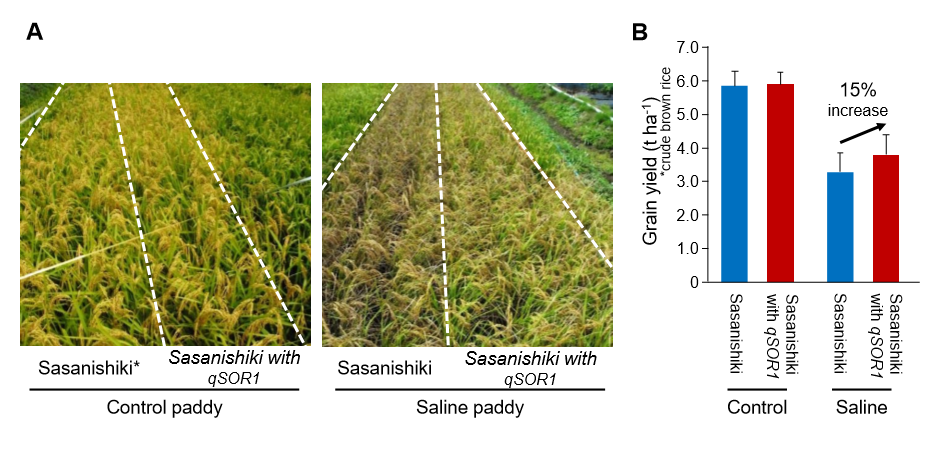The National Agriculture and Food Research Organization (NARO), in collaboration with Tohoku University and the National Institute of Advanced Industrial Science and Technology (AIST) have succeeded in the world's first identification of qSOR1 (quantitative trait locus for SOIL SURFACE ROOTING 1) gene in rice associated with root growth angle (RGA), which is useful in the breeding aiming at mitigating grain yield damage in saline paddy fields. Grain yield damage from saline stress occurs not only from the salt itself but also from the deficiency of oxygen occurred by the degraded physical soil condition. In this study, qSOR1 was used for the development of new rice line which developed soil-surface roots (SOR). The SOR could gain more oxygen from the air rather than roots developed into subsoil with oxygen deficient condition. As a consequence, grain yield of new rice line with SOR was less affected than the parental cultivar 'Sasanishiki' without SOR. The qSOR1 is expected to contribute to the rice breeding aiming at assuring stable rice production in the areas such as the coastal areas of Japan and tropical Asia threatened by the increasing risk of salinity in paddy after high tide flooding as part of the impact of global climate change.
Overview
Salinity together with drought is a major cause of agricultural production damage in the world. By 2050, supposedly half of the existing arable land will be affected by salinity. In fact, agricultural production in many parts of the coastal areas around the world including Japan is already affected by the increasing threats of salinity caused by various reasons: frequent high tide as a result of rising sea level, violent typhoons as a result of recent global warming, and reduction of river flow and saltwater intrusion as an impact of massive water usage in the upstream such as dam construction and so forth. There is a worldwide demand for saline-resilient cultivars in various crops including rice.
Recalling NARO's past research result in 2013, we succeeded in the world's first development of rice line with drought resistance by modifying RGA. Now in the recent study, NARO, in a joint-research project with Tohoku University, have identified qSOR1 gene in rice associated with RGA to develop SOR and became the first in the world to breed rice adapted to saline paddy by modifying root system architecture. Introduction of non-functinal allele at qSOR1 contributed in increasing grain yields by more than 15% compared to the parental cultivar without SOR. The result shows that qSOR1 is useful breeding materials to avoid the grain yield damage caused by oxygen deficiencies in saline paddy fields. It is also expected to be useful in the other breeding aiming at mitigating a root-rot damage in oxygen-deficient soils, which is a rising problem in high viscosity paddies, paddies with iron deficiency and poorly drained paddies. The research results were published online on August 17th, 2020 in the international scientific journal Proceedings of the National Academy of Sciences of the United States of America.
Publications
Kitomi Y, Hanzawa E, Kuya N, Inoue H, Hara N, Kawai S, Kanno N, Endo M, Sugimoto K, Yamazaki T, Sakamoto S, Sentoku N, Wu J, Kanno H, Mitsuda N, Toriyama K, Sato T, Uga Y. Root angle modifications by the DRO1 homolog improve rice yields in saline paddy fields.Proceedings of the National Academy of Sciences of the United States of America
https://www.pnas.org/cgi/doi/10.1073/pnas.2005911117
For Inquiries
Contact: http://www.naro.affrc.go.jp/english/inquiry/index.html
Reference Information

Fig.1 Relationship between the environmental stress in saline paddy field and root system architecture
The main cause of the production damage in saline paddy field is not only the salt itself but also the oxygen-deficient state of soil in degraded soil physical condition. However, surface soil has relatively more oxygen content than in the subsoil. Therefore, rice cultivar which develops soil-surface roots will obtain more oxygen than the common rice cultivar resulting in the reduced damage from saline stress.

Fig.2 Development of soil-surface roots by introduction of qSOR1 gene
qSOR1 locates on the rice chromosome 7 in the rice genotype (chromosome 1-12). When functional qSOR1 of Sasanishiki is replaced by non-functional qSOR1 of Gemdjah Beton by crossbreeding, the new rice line will develop soil-surface roots. (A) Graphical genotypes of rice (B) Development of soil-surface roots seen after removing water from paddy field. Yellow arrowhead in the image: position of crown roots.
*Sasanishiki: modern japonica lowland rice cultivar in Japan that does not grow soil-surface roots.

Fig.3 Effects of soil-surface roots on grain yield increase in saline paddy fields
(A) Rice conditions with fresh or saline water at the stage of maturity. In the control paddy field with fresh water, both Sasanishiki and the new rice line have similar color of leaves (on the left). In saline conditions, Sasanishiki showed leaf bronzing, in comparison with the healthier and greener leaves of new rice line (on the right). (B) Comparison of the grain yields between the control and saline paddy fields. Data shows average grain yields over 4 years (2015 - 2018). New rice line with SOR had increased grain yield by 15 % compared to Sasanishiki.

Fig.4 Effects of the genetic interactions of qSOR1 and DRO1 on the root system architecture
The parenthesis shows the functional (+) and non-functional (-) type of the target genotype. Comparing root distributions of four lines obtained with different combination of genotypes (functional/non-functional) in the IR64 background through DNA marker-assisted selection.




